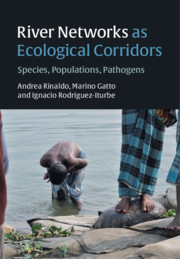Crossref Citations
This Book has been
cited by the following publications. This list is generated based on data provided by Crossref.
Gatto, Marino
Bertuzzo, Enrico
Mari, Lorenzo
Miccoli, Stefano
Carraro, Luca
Casagrandi, Renato
and
Rinaldo, Andrea
2020.
Spread and dynamics of the COVID-19 epidemic in Italy: Effects of emergency containment measures.
Proceedings of the National Academy of Sciences,
Vol. 117,
Issue. 19,
p.
10484.
Carraro, Luca
Bertuzzo, Enrico
Fronhofer, Emanuel A.
Furrer, Reinhard
Gounand, Isabelle
Rinaldo, Andrea
and
Altermatt, Florian
2020.
Generation and application of river network analogues for use in ecology and evolution.
Ecology and Evolution,
Vol. 10,
Issue. 14,
p.
7537.
Giezendanner, J.
Benettin, P.
Durighetto, N.
Botter, G.
and
Rinaldo, A.
2021.
A Note on the Role of Seasonal Expansions and Contractions of the Flowing Fluvial Network on Metapopulation Persistence.
Water Resources Research,
Vol. 57,
Issue. 11,
Bertassello, Leonardo
Levy, Morgan C.
and
Müller, Marc F.
2021.
Sociohydrology, ecohydrology, and the space-time dynamics of human-altered catchments.
Hydrological Sciences Journal,
Vol. 66,
Issue. 9,
p.
1393.
Calamita, Elisa
Siviglia, Annunziato
Gettel, Gretchen M.
Franca, Mário J.
Winton, R. Scott
Teodoru, Cristian R.
Schmid, Martin
and
Wehrli, Bernhard
2021.
Unaccounted CO
2
leaks downstream of a large tropical hydroelectric reservoir
.
Proceedings of the National Academy of Sciences,
Vol. 118,
Issue. 25,
Bertassello, L. E.
Jawitz, J. W.
Bertuzzo, E.
Botter, G.
Rinaldo, A.
Aubeneau, A. F.
Hoverman, J. T.
and
Rao, P. S. C.
2022.
Persistence of amphibian metapopulation occupancy in dynamic wetlandscapes.
Landscape Ecology,
Vol. 37,
Issue. 3,
p.
695.
Gatto, Marino
and
Casagrandi, Renato
2022.
Ecosystem Conservation and Management.
p.
105.
Rinaldo, Andrea
and
Rodriguez-Iturbe, Ignacio
2022.
Ecohydrology 2.0.
Rendiconti Lincei. Scienze Fisiche e Naturali,
Vol. 33,
Issue. 2,
p.
245.
Ezzat, Leïla
Fodelianakis, Stilianos
Kohler, Tyler J.
Bourquin, Massimo
Brandani, Jade
Busi, Susheel Bhanu
Daffonchio, Daniele
De Staercke, Vincent
Marasco, Ramona
Michoud, Grégoire
Oppliger, Emmy
Peter, Hannes
Pramateftaki, Paraskevi
Schön, Martina
Styllas, Michail
Tadei, Virginia
Tolosano, Matteo
Battin, Tom J.
and
Rudi, Knut
2022.
Benthic Biofilms in Glacier-Fed Streams from Scandinavia to the Himalayas Host Distinct Bacterial Communities Compared with the Streamwater.
Applied and Environmental Microbiology,
Vol. 88,
Issue. 12,
Trevisin, Cristiano
Lemaitre, Joseph C.
Mari, Lorenzo
Pasetto, Damiano
Gatto, Marino
and
Rinaldo, Andrea
2022.
Epidemicity of cholera spread and the fate of infection control measures.
Journal of The Royal Society Interface,
Vol. 19,
Issue. 188,
Levin, Simon A.
and
Rinaldo, Andrea
2022.
Ignacio Rodríguez-Iturbe (1942–2022): A review of a pathbreaking academic career combining chance and self-organization.
Proceedings of the National Academy of Sciences,
Vol. 119,
Issue. 49,
Mathers, Kate L.
Guareschi, Simone
and
Pattison, Zarah
2022.
Biological invasions in rivers and associated ecosystems: New insights, challenges, and methodological advancements.
River Research and Applications,
Vol. 38,
Issue. 8,
p.
1351.
Bassi, Roberto
Rinaldo, Andrea
and
Seminara, Giovanni
2022.
The intrusion of ecology into hydrology and morphodynamics.
Rendiconti Lincei. Scienze Fisiche e Naturali,
Vol. 33,
Issue. 2,
p.
213.
Gatto, Marino
and
Casagrandi, Renato
2022.
Ecosystem Conservation and Management.
p.
231.
Carraro, Luca
and
Altermatt, Florian
2022.
Optimal Channel Networks accurately model ecologically-relevant geomorphological features of branching river networks.
Communications Earth & Environment,
Vol. 3,
Issue. 1,
Nicoletti, Giorgio
Padmanabha, Prajwal
Azaele, Sandro
Suweis, Samir
Rinaldo, Andrea
and
Maritan, Amos
2023.
Emergent encoding of dispersal network topologies in spatial metapopulation models.
Proceedings of the National Academy of Sciences,
Vol. 120,
Issue. 46,
Ho, Hsi-Cheng
Altermatt, Florian
and
Carraro, Luca
2023.
Coupled biological and hydrological processes shape spatial food-web structures in riverine metacommunities.
Frontiers in Ecology and Evolution,
Vol. 11,
Issue. ,
Radici, Andrea
Claudet, Joachim
Ligas, Alessandro
Bitetto, Isabella
Lembo, Giuseppe
Spedicato, Maria Teresa
Sartor, Paolo
Piccardi, Carlo
and
Melià, Paco
2023.
Assessing fish–fishery dynamics from a spatially explicit metapopulation perspective reveals winners and losers in fisheries management.
Journal of Applied Ecology,
Vol. 60,
Issue. 11,
p.
2482.
Miele, Filippo
Benettin, Paolo
Wang, Simiao
Retti, Ivan
Asadollahi, Mitra
Frutschi, Manon
Mohanty, Binayak
Bernier‐Latmani, Rizlan
and
Rinaldo, Andrea
2023.
Spatially Explicit Linkages Between Redox Potential Cycles and Soil Moisture Fluctuations.
Water Resources Research,
Vol. 59,
Issue. 3,
Mathers, Kate L.
Clinton, Kelly
Constable, Drew
Gerrard, Chris
Patel, Charlie
and
Wood, Paul J.
2023.
Invasion dynamics of Ponto‐Caspian amphipods leads to changes in invertebrate community structure and function.
Ecosphere,
Vol. 14,
Issue. 7,





